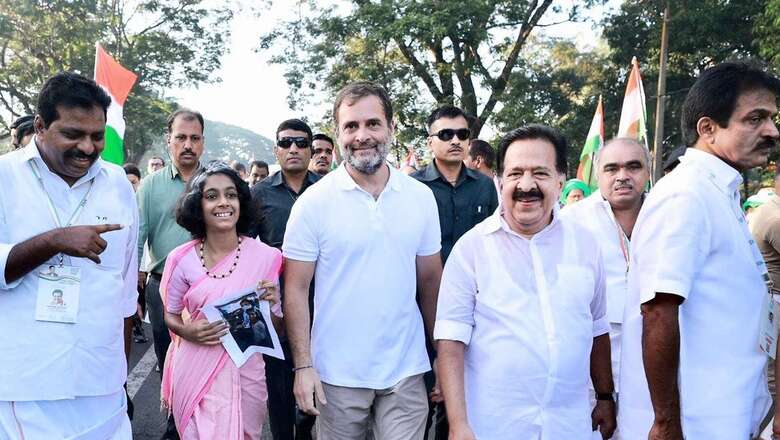
views
Rahul Gandhi cuddling infants, kneeling to tie his mother’s shoelaces, standing in the driving rain to speak to a crowd of supporters. Rahul Gandhi clambering up an 80-foot water tank, doing push-ups on the road, hefting children onto his shoulders, and hugging the elderly. The images from the Bharat Jodo Yatra render the Congress scion more likeable than he has ever been.
Fit at 50, he is a picture of youthful vitality, while his salt-and-pepper beard lends a touch of maturity. Has Rahul Gandhi, after nearly two decades of struggling to reinvent himself, finally managed to morph from pampered princeling to man of the people?
The images of Gandhi are heart-warming precisely because they are unexpected. To see a child of privilege braving the heat and dust of the road to get up close and personal with people is charming in itself.
Belying expectations that it would be the usual roadshow, barely skimming the ground, he has chosen to do the actual footwork. His willingness to sacrifice comfort and security concerns is seen as a sign of graciousness and grit. A grassroots leader who has come up from the ranks would not have the same emotional appeal.
Although Gandhi’s 3,570-km ‘long march’ has certainly generated public goodwill, and a proactive Congress brings a sense of relief to those who fear a BJP hegemony, the question is whether the Grand Old Party can sustain the momentum of the exercise and parley it into a revival of its electoral fortunes.
There’s no doubt that the enthusiastic public response to Gandhi has rattled the BJP in Karnataka, which goes to polls next year and has been a focus area (like Kerala) of the padayatra. He certainly took the shine out of the BJP’s Jan Sankalp Yatra, which featured a series of rallies by helicopter-borne netas, but that doesn’t necessarily argue electoral gains.
Three decades ago, a Rath Yatra altered the shape of Indian politics and set in motion a series of events that culminated with the BJP displacing the Congress as the dominant national party. It would be too much hope that a padayatra will do the same for the Congress.
A padayatra has a political and an emotional component. It humanises the neta and ensures the broadest possible interface with the public. You can reach out and touch him, feel the slickness of sweat on his arm. He puts himself on an equal footing with the people and becomes a co-traveller rather than a leader.
Is Gandhi’s padayatra an example of political royalty ‘slumming it’ in order to garner votes? Does it smack of theatrics, and is the public mobilisation largely orchestrated? Probably, but that does not matter. The purpose was to distance himself from his dilettante image, and he is doing his best. He is more confident, poised, and at ease than ever before, and that has galvanised party workers.
In terms of political action, a padayatra recalls Mahatma Gandhi’s Dandi March, the purest form of civil resistance against an oppressive regime. It is an act of protest, a non-violent challenge to the powers that be, and a demand for justice or change.
Therein lies the problem. What exactly is Gandhi hoping to change? Bharat Jodo implies bringing a divided nation together. His speeches reflect the usual trope of ‘politics of hatred and divisiveness’. This theme has limited appeal, except among a section of die-hard Congress supporters and intellectuals, precisely because India does not see itself as divided.
His attack on price rise, unemployment, and other examples of alleged financial mismanagement are likely to have more traction, but the trouble as always is that he has no counter-narrative to offer. The Congress has yet to present a credible plan to tackle joblessness, price rise, and agricultural woes while keeping the economy on track.
Gandhi is not fighting the BJP; he is fighting Prime Minister Narendra Modi’s vision of India. And the sheer power of that narrative is overwhelming. India as a global power, a $5 trillion economy built on ‘Make in India’, leading the world in pharmaceuticals, automotives, software, electronics, textiles, and so on. India as an ancient civilisation, a united nation founded on common cultural values, with the capacity to transform the modern world.
Trashing the vision will not yield results for the Congress, because for every person who sees ‘Bharat ascending’ as smoke and mirrors, there are two who buy into it. An even more formidable challenge for the Congress is that PM Modi has shown himself capable of changing social behaviours, judging by the ‘Swachh Bharat’ and ‘Beti Padhao/Bachao’ campaigns.
So, while we are getting to see a much more engaging side of Gandhi, we also need to hear him, to understand what’s on the table in terms of his idea of India. The Bharat Jodo Yatra may well be a landmark in RaGa’s political journey, but he still has a long way to go.
Bhavdeep Kang is a freelance writer and author of ‘Gurus: Stories of India’s Leading Babas’ and ‘Just Transferred: The Untold Story of Ashok Khemka’. A journalist since 1986, she has written extensively on national politics. The views expressed in this article are those of the author and do not represent the stand of this publication.
Read all the Latest Opinion News and Breaking News here


















Comments
0 comment